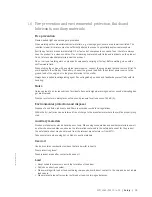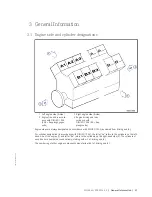
1.6 Fire prevention and environmental protection, fluids and
lubricants, auxiliary materials
Fire prevention
Flames, naked light and smoking are prohibited.
When working with combustible indirect materials, e.g. cleaning agent, ensure area is well ventilated. The
resultant steam/air mixture must be sufficiently diluted to prevent a potentially explosive atmosphere.
Rectify any fuel or oil leaks immediately. Oil or fuel on hot components can cause fires – therefore always
keep the product in a clean condition. Do not leave rags saturated with fluids and lubricants on the product.
Do not store combustible materials near the product.
Do not carry out welding work on pipes and components carrying oil or fuel. Before welding, clean with a
nonflammable fluid.
When starting the engine with an external power source, connect the ground lead last and remove it first. To
avoid sparks in the vicinity of the battery, connect the ground lead from the external power source to the
ground lead of the engine or to the ground terminal of the starter.
Always have a suitable extinguishing agent (fire extinguisher) on hand and familiarize yourself fully with its
handling.
Noise
Noise can lead to an increased risk of accidents if acoustic signals, warning shouts or sounds indicating dan-
ger are drowned.
Wear ear protectors in workplaces with a sound pressure level in excess of 85 dB (A).
Environmental protection and disposal
Dispose of used fluids, lubricants and filters in accordance with local regulations.
Within the EU, batteries can be returned free of charge to the manufacturer where they will be properly recy-
cled.
Auxiliary materials
Process materials may also be hazardous or toxic. When using consumables and auxiliary materials as well
as other chemical substances, observe the information contained in the safety data sheet for the product.
The safety data sheet may be obtained from the relevant manufacturer or from MTU.
Take special care when using hot, chilled or caustic materials.
Used oil
Used oil contains combustion residues that are harmful to health.
Wear protective gloves!
Wash relevant areas after contact with used oil.
Lead
• Adopt suitable measures to avoid the formation of lead dust.
• Switch on extraction system.
• When working with lead or lead-containing compounds, avoid direct contact to the skin and do not inhale
lead vapors.
• Wash relevant areas after contact with lead or lead-containing substances.
M015565/03E 2016-02
| Safety | 13
TIM-ID: 0000040536 - 010














































